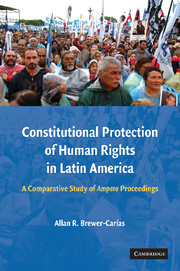 Constitutional Protection of Human Rights in Latin America
Constitutional Protection of Human Rights in Latin America Book contents
- Frontmatter
- Contents
- INTRODUCTION
- PART ONE THE CONSTITUTIONAL AND INTERNATIONAL DECLARATION OF HUMAN RIGHTS AND ITS JUDICIAL GUARANTIES
- PART TWO THE AMPARO AS A LATIN AMERICAN CONSTITUTIONAL AND INTERNATIONAL LAW INSTITUTION
- PART THREE THE INJURED PARTY AND THE CONSTITUTIONAL RIGHTS PROTECTED BY MEANS OF THE AMPARO PROCEEDING
- PART FOUR THE INJURY, THE INJURING PARTY AND THE INJURING ACTS OR OMISSIONS IN THE AMPARO PROCEEDING
- PART FIVE THE EXTRAORDINARY CHARACTER OF THE AMPARO PROCEEDING
- Chapter Seventeen The Question of the Admissibility of the Amparo Action and Its Relation with the Ordinary Judicial Means
- Chapter Eighteen The Main Principles of the Procedure in the Amparo Proceeding
- Chapter Nineteen The Configuration of the Main Phases of the Amparo Proceeding
- Chapter Twenty The Adjudication in the Amparo Proceeding and the Preliminary Protective Measures
- Chapter Twenty-One The Definitive Judicial Adjudication in the Amparo Suit
- Chapter Twenty-Two The Revision of the Amparo Decisions by the Constitutional Court or the Supreme Court
- CONCLUSION
- APPENDIX A List of Latin American Constitutions
- APPENDIX B List of Latin American Amparo Laws (Statutes)
- INDEX
Chapter Twenty-One - The Definitive Judicial Adjudication in the Amparo Suit
Published online by Cambridge University Press: 08 August 2009
- Frontmatter
- Contents
- INTRODUCTION
- PART ONE THE CONSTITUTIONAL AND INTERNATIONAL DECLARATION OF HUMAN RIGHTS AND ITS JUDICIAL GUARANTIES
- PART TWO THE AMPARO AS A LATIN AMERICAN CONSTITUTIONAL AND INTERNATIONAL LAW INSTITUTION
- PART THREE THE INJURED PARTY AND THE CONSTITUTIONAL RIGHTS PROTECTED BY MEANS OF THE AMPARO PROCEEDING
- PART FOUR THE INJURY, THE INJURING PARTY AND THE INJURING ACTS OR OMISSIONS IN THE AMPARO PROCEEDING
- PART FIVE THE EXTRAORDINARY CHARACTER OF THE AMPARO PROCEEDING
- Chapter Seventeen The Question of the Admissibility of the Amparo Action and Its Relation with the Ordinary Judicial Means
- Chapter Eighteen The Main Principles of the Procedure in the Amparo Proceeding
- Chapter Nineteen The Configuration of the Main Phases of the Amparo Proceeding
- Chapter Twenty The Adjudication in the Amparo Proceeding and the Preliminary Protective Measures
- Chapter Twenty-One The Definitive Judicial Adjudication in the Amparo Suit
- Chapter Twenty-Two The Revision of the Amparo Decisions by the Constitutional Court or the Supreme Court
- CONCLUSION
- APPENDIX A List of Latin American Constitutions
- APPENDIX B List of Latin American Amparo Laws (Statutes)
- INDEX
Summary
THE GENERAL CONDITIONS OF THE DECISION
Regarding the definitive judicial decisions in the amparo proceedings, their purpose for the injured party (the plaintiff) is to obtain the requested judicial protection (amparo, tutela, protección) of his constitutional rights when illegitimately harmed or threatened by an injuring party (the defendant).
Consequently, the final result of the process, characterized by its bilateral nature that imposes the need for the defendants to have the right to participate and to be heard, is a formal judicial decision or order issued by the court for the protection of the threatened rights or to restore the enjoyment of the harmed one, which can consist, for instance, in a decision commanding or preventing an action, or commanding someone to do, not to do or to undo some action. This is to say, the amparo, as the injunction, is a writ framed according to the circumstances of the case commanding an act that the court regards as essential in justice, or restraining an act that it deems contrary to equity and good conscience.
Consequently, the function of the amparo court's decision is, on the one hand, to prevent the defendant from inflicting further injury on the plaintiff, that can be of a prohibitory or mandatory character; or on the other hand, to correct the present by undoing the effects of a past wrong.
- Type
- Chapter
- Information
- Constitutional Protection of Human Rights in Latin AmericaA Comparative Study of Amparo Proceedings, pp. 377 - 396Publisher: Cambridge University PressPrint publication year: 2008


